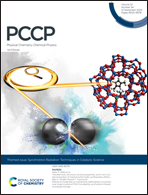Critical insights into the interactions of heat shock protein 70 with phospholipids†
Abstract
Heat shock proteins (Hsps) stabilize the newly synthesized polypeptide chains preventing them from aggregation. They contribute to systemic response under stress and thus behave as signaling molecules. Hsp70 has been detected on the surface of stressed cells. It translocates to the extracellular environment through the plasma membrane without causing cell death. But the interaction of the protein with the membrane leading to the export process remains elusive. Hsp70 has a tendency to generate channels within lipid bilayers, and this has been a driving force for studying protein–lipid interactions. Transport of these proteins across the membrane paves their pathways for performing the desired function. We have attempted to characterize how the interaction of Hsp70 with negatively charged phospholipids affects the structure of lipids. This study will help in explaining the transport mechanism of proteins that are devoid of defined signaling pathways. The interaction of amino acids of Hsp70 with the head and tail group leads to the rearrangement of the hydration layer in contact with the bilayers. Critical analysis of the results obtained from small-angle X-ray scattering along with QCM-D provides valuable insights to analyze the effect of Hsp70 adsorption on an anionic POPS lipid bilayer.



 Please wait while we load your content...
Please wait while we load your content...